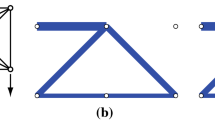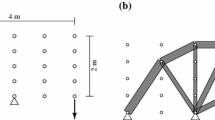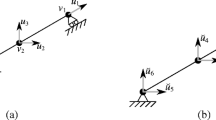Abstract
This paper addresses the compliance minimization of a truss, where the number of available nodes is limited. It is shown that this optimization problem can be recast as a second-order cone programming with a cardinality constraint. We propose a simple heuristic based on the alternative direction method of multipliers. The efficiency of the proposed method is compared with a global optimization approach based on mixed-integer second-order cone programming. Numerical experiments demonstrate that the proposed method often finds a solution having a good objective value with small computational cost.














Similar content being viewed by others
Notes
It can also be rewritten as
$$\begin{aligned} t + 1 \ge \left\|\left[\begin{array}{c} t - 1 \\ 2(Z \varvec{x} - \varvec{z}^{k} + \varvec{v}^{k}) \\ \end{array} \right]\right\| , \end{aligned}$$which is a second-order cone constraint.
Since G is nonconvex, the projection of a point onto G is not necessarily unique.
Through our preliminary numerical experiments it was found that the computational cost required by MOSEK does not change drastically depending on the value of M.
To obtain these solutions, we used the ground structures without overlap** members.
It should be clear that no initial point was assigned for the MISOCP approach, although in Table 2, for convenience of presentation, the results of MISOCP are placed in the rows concerning the results of the ADMM with initial point (A).
References
Anjos MF, Lasserre JB (eds) (2012) Handbook on semidefinite, conic and polynomial optimization. Springer, New York
Achtziger W (1999) Local stability of trusses in the context of topology optimization part I: exact modelling. Struct Optim 17:235–246
Andersen ED, Roos C, Terlaky T (2003) On implementing a primal-dual interior-point method for conic quadratic optimization. Math Program 95:249–277
Arastoo R, Bahavarnia M, Kothare MV, Motee N (2015) Output feedback controller sparsification via \(\cal{H}_{2}\)-approximation. IFAC-PapersOnLine 48:112–117
Asadpoure A, Guest JK, Valdevit L (2015) Incorporating fabrication cost into topology optimization of discrete structures and lattices. Struct Multidiscip Optim 51:385–396
Bendsøe MP, Ben-Tal A, Zowe J (1994) Optimization methods for truss geometry and topology design. Struct Optim 7:141–159
Ben-Tal A, Nemirovski A (1997) Robust truss topology optimization via semidefinite programming. SIAM J Optim 7:991–1016
Ben-Tal A, Nemirovski A (2001) Lectures on modern convex optimization: analysis, algorithms, and engineering applications. SIAM, Philadelphia
Bertsimas D, Shioda R (2009) Algorithm for cardinality-constrained quadratic optimization. Comput Optim Appl 43:1–22
Boyd S, Parikh N, Chu E, Peleato B, Eckstein J (2010) Distributed optimization and statistical learning via the alternating direction method of multipliers. Found Trends Mach Learn 3:1–122
Bruckstein AM, Donoho DL, Elad M (2009) From sparse solutions of systems of equations to sparse modeling of signals and images. SIAM Rev 51:34–81
Burdakov OP, Kanzow C, Schwartz A (2016) Mathematical programs with cardinality constraints: reformulation by complementarity-type conditions and a regularization method. SIAM J Optim 26:397–425
Candès EJ, Wakin MB, Boyd SP (2008) Enhancing sparsity by reweighted \(\ell _{1}\) minimization. J Fourier Anal Appl 14:877–905
Chartrand R (2007) Exact reconstruction of sparse signals via nonconvex minimization. IEEE Signal Process Lett 14:707–710
Chartrand R (2012) Nonconvex splitting for regularized low-rank \(+\) sparse decomposition. IEEE Trans Signal Process 60:5810–5819
Chartrand R, Wohlberg B (2013) A nonconvex ADMM algorithm for group sparsity with sparse groups. In: 2013 IEEE international conference on acoustics, speech and signal processing, Vancouver, pp 6009–6013 (2013)
Cui XT, Zheng XJ, Zhu SS, Sun XL (2013) Convex relaxations and MIQCQP reformulations for a class of cardinality-constrained portfolio selection problems. J Glob Optim 56:1409–1423
Diamond S, Takapoui R, Boyd S (2018) A general system for heuristic minimization of convex functions over non-convex sets. Optim Methods Softw 33:165–193
Gotoh J, Takeda A, Tono K (2018) DC formulations and algorithms for sparse optimization problems. Math. Program., to appear. https://doi.org/10.1007/s10107-017-1181-0
Grant M, Boyd S (2008) Graph implementations for nonsmooth convex programs. In: Blondel V, Boyd S, Kimura H (eds) Recent advances in learning and control (a tribute to M. Vidyasagar). Springer, Berlin, pp 95–110
Grant M, Boyd S (2017) CVX: Matlab software for disciplined convex programming, version 2.1. http://cvxr.com/cvx/. Accessed Jan 2017
Guo X, Cheng GD, Olhoff N (2005) Optimum design of truss topology under buckling constraints. Struct Multidiscip Optim 30:169–180
Gurobi Optimization, Inc.: Gurobi optimizer reference manual. http://www.gurobi.com/. Accessed Sept 2016
He L, Gilbert M (2015) Rationalization of trusses generated via layout optimization. Struct Multidiscip Optim 52:677–694
Hegemier GA, Prager W (1969) On Michell trusses. Int J Mech Sci 11:209–215
Kanamori T, Takeda A (2014) Numerical study of learning algorithms on Stiefel manifold. CMS 11:319–340
Kanno Y (2013) Damper placement optimization in a shear building model with discrete design variables: a mixed-integer second-order cone programming approach. Earthq Eng Struct Dyn 42:1657–1676
Kanno Y (2016a) Global optimization of trusses with constraints on number of different cross-sections: a mixed-integer second-order cone programming approach. Comput Optim Appl 63:203–236
Kanno Y (2016b) Mixed-integer second-order cone programming for global optimization of compliance of frame structure with discrete design variables. Struct Multidiscip Optim 54:301–316
Kanno Y, Yamada H (2017) A note on truss topology optimization under self-weight load: mixed-integer second-order cone programming approach. Struct Multidiscip Optim 56:221–226
Kirsch U (1989) Optimal topologies of structures. Appl Mech Rev 42:223–239
Kočvara M (2017) Truss topology design by linear conic optimization. In: Terlaky T, Anjos MF, Ahmed S (eds) Advances and trends in optimization with engineering applications. SIAM, Philadelphia
Le Thi HA, Dinh TP, Le HM, Vo XT (2015) DC approximation approaches for sparse optimization. Eur J Oper Res 244:26–46
Lin F, Fardad M, Jovanović MR (2013) Design of optimal sparse feedback gains via the alternating direction method of multipliers. IEEE Trans Autom Control 58:2426–2431
Löfberg J (2004) YALMIP: a toolbox for modeling and optimization in MATLAB. In: 2004 IEEE international conference on computer aided control system design, Taipei, pp 284–289 (2004)
Magnússon S, Rabbat MG, Fischione C (2016) On the convergence of alternating direction Lagrangian methods for nonconvex structured optimization problems. IEEE Trans Control Netw Syst 3:296–309
Masazade E, Fardad M, Varshney PK (2012) Sparsity-promoting extended Kalman filtering for target tracking in wireless sensor networks. IEEE Signal Process Lett 19:845–848
Mazurek A (2012) Geometrical aspects of optimum truss like structures for three-force problem. Struct Multidiscip Optim 45:21–32
Mazurek A, Baker WF, Tort C (2011) Geometrical aspects of optimum truss like structures. Struct Multidiscip Optim 43:231–242
Mela K (2014) Resolving issues with member buckling in truss topology optimization using a mixed variable approach. Struct Multidiscip Optim 50:1037–1049
Michell AGA (1904) The limits of economy of material in frame-structures. Lond Edinb Dublin Philos Mag J Sci 8:589–597
Miyashiro R, Takano Y (2015) Mixed integer second-order cone programming formulations for variable selection in linear regression. Eur J Oper Res 247:721–731
Natarajan BK (1995) Sparse approximate solutions to linear systems. SIAM J Comput 24:227–234
Ohsaki M (2011) Optimization of finite dimensional structures. CRC Press, Boca Raton
Ohsaki M, Kanno Y, Tsuda S (2014) Linear programming approach to design of spatial link mechanism with partially rigid joints. Struct Multidiscip Optim 50:945–956
Parkes EW (1975) Joints in optimum frameworks. Int J Solids Struct 11:1017–1022
Pólik I (2005) Addendum to the SeDuMi user guide: version 1.1. Technical Report, Advanced Optimization Laboratory, McMaster University, Hamilton (2005). http://sedumi.ie.lehigh.edu/
Prager W (1977) Optimal layout of cantilever trusses. J Optim Theory Appl 23:111–117
Prager W (1978) Optimal layout of trusses with finite numbers of joints. J Mech Phys Solids 26:241–250
Rozvany GIN (1996) Difficulties in truss topology optimization with stress, local buckling and system stability constraints. Struct Optim 11:213–217
Sagnol G (2012) PICOS: a python interface for conic optimization solvers. http://picos.zib.de/. Accessed Feb 2017
Sturm JF (1999) Using SeDuMi 1.02, a MATLAB toolbox for optimization over symmetric cones. Optim Methods Softw 11(12):625–653
Takapoui R, Moehle N, Boyd S, Bemporad A (2018) A simple effective heuristic for embedded mixed-integer quadratic programming. Int J Control, to appear. https://doi.org/10.1080/00207179.2017.1316016
Top** BHV (1983) Shape optimization of skeletal structures: a review. J Struct Eng 109:1933–1951
Torii AJ, Lopez RH, Miguel LFF (2016) Design complexity control in truss optimization. Struct Multidiscip Optim 54:289–299
Tütüncü RH, Toh KC, Todd MJ (2003) Solving semidefinite-quadratic-linear programs using SDPT3. Math Program B95:189–217
Zheng X, Sun X, Li D, Sun J (2014) Successive convex approximations to cardinality-constrained convex programs: a piecewise-linear DC approach. Comput Optim Appl 59:379–397
Acknowledgements
The authors thank the referees and the editors for providing us with the detailed comments and suggestions, which were helpful in revision. The work of the first author is partially supported by JSPS KAKENHI 15KT0109 and 17K06633.
Author information
Authors and Affiliations
Corresponding author
Rights and permissions
About this article
Cite this article
Kanno, Y., Fujita, S. Alternating direction method of multipliers for truss topology optimization with limited number of nodes: a cardinality-constrained second-order cone programming approach. Optim Eng 19, 327–358 (2018). https://doi.org/10.1007/s11081-017-9372-3
Received:
Revised:
Accepted:
Published:
Issue Date:
DOI: https://doi.org/10.1007/s11081-017-9372-3




